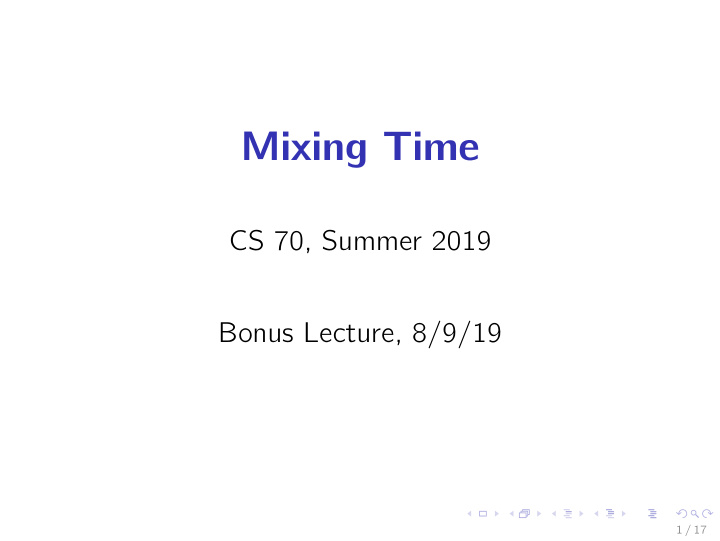



Mixing Time CS 70, Summer 2019 Bonus Lecture, 8/9/19 1 / 17
Disclaimer: Much handwaving today!! Goal is to get a high level intuition / picture for the concept of mixing time and applications Emphasis is on heuristics rather than rigor 2 / 17
What We Know... Every irreducible, aperiodic Markov chain has a unique stationary distribution. ' n' HIFI IT = π m (1) m 0 . 8 0 . 2 0 π m = π 0 P m = π 0 0 0 . 3 0 . 7 . 0 . 6 0 . 4 0 π m (2) π m (3) m Q: How long does it take to get close to the stationary distribution? 3 / 17
Total Variation Distance Just one of many ways to measure how close two distributions are. n } { 1,2 , States over . , . . → Let P 1 , P 2 be two PMFs. Their TV distance is: - Elif / Phil Estates i thing lighted 4 / 17
↳ Mixing Time: Definition I have an irreducible, aperiodic Markov chain. Notation: µ ( n ) is the distribution at time n , and ⇡ is its (unique) stationary distribution . - I want to keep running my chain until: ( UM , Tl ) positive d E small E ← Tv number time in stationary 9 dist at The mixing time t mix ( " ) is the first time this di St happens. starting case worst . (Omitted fact: The TV distance between µ ( n ) l l U and ⇡ decreases as n increases.) prob , at least with high 5 / 17
Complete Graph With Loops a 0%7*0 Mixing time analysis sometimes direct! a ① Take a random walk on a complete graph with loops . What is the stationary distribution? kn ftnh : . In ] symbtanwtnfn F- . . vertices What does the transition matrix look like? . ÷ - TIME ' up - .int . , . . = IT Mixing Time? Dependence on " ? 1 for E all . . 6 / 17
I Random-To-Top Shu ffl ing I con figs n ! S : All orderings of n cards in a deck. . Transitions: Choose card randomly in the deck. Move it to the top. all States here uniform is over Tl . Di ff erent strategy called coupling: assume ← arena ; Hed . A T chosen I # arbitrary start at v. a. r . State we keep applying p , . at it Stays dist . . 7 / 17
Random-To-Top Shu ffl ing II At each time, each card is labeled coupled or not. number Initially, all cards start uncoupled . Pick a random card C . number In both decks, take card C and move it to the top. If C isn’t already coupled, mark it as coupled . What happens when we look at each deck - top - to individually? like random LOOKS ! move " coupled ; ④ once # labeled a IS it has same the position both decks ! in 8 / 17
Random-To-Top Shu ffl ing III Time until all cards get coupled = time until Deck 1 is fully random. me 2nd 1st 3rd -13 T2 couple couple couple - - . 't const Geomfnnt ) Geomftn ) . " collector coupon . ECT .tTnT=nl0gN , -1T , -1 . . . 0cnu④ " For all ✏ : t mix ( " ) = ?9eEuFo¥ " 9 / 17
Random Hypercube Walk I - length vertices n Take an n -dimensional hypercube. bit strings Stationary distribution of hypercube walk: In F- Cfn . In ] vertices all . . same deg Try coupling again: . ④ Lazywatk vertex self loop Wp 's Every : transitions to up In Nbr iarbitraryvertexi → truly random : bits all randomize 10 / 17
Random Hypercube Walk II Each coordinate is labeled coupled or not. Initially all coordinates are uncoupled . Pick a random coordinate i . Flip a coin to set the i -th coordinate to 0 or 1. If i -th coordinate is uncoupled , set it to coupled. Ef time . randomized ] all N log N = word 11 / 17
Random Hypercube Walk III Use Coupon Collector again! before as same . For all " , t mix ( " ) = 12 / 17
Conditions for Fast Mixing? Complete graph K n ? =L middle Start Path on n vertices? in . NZ mixing time ow - • - Dumbbell? nz mixing time mgaehffengnere pink dot chance f- . from getting hmltgefdte 13 / 17
Bottlenecks We use a measurement called the conductance to quantify the notion of a bottleneck. E A 0¥ The conductance of a set A ⊆ S is: Milk ; EA ,jEA Φ ( A ) = - jeep 'll ← VOILA ) The conductance of the chain M is: min ECA ) Φ ( M ) = Ast VOKAKE 14 / 17
How To Measure Conductance? Measuring conductance = looking at all subsets ± of states with vol ( A ) ≤ 2. How many subsets, potentially? Alternative: Get lower bound on Φ ( M ) using second largest eigenvalue of transition matrix. Φ ( M ) ≥ 2 Eigenvalues are much faster to compute! 15 / 17
Markov Chain Monte Carlo Monte Carlo: randomized algorithm where the output is allowed to be incorrect Use cases: I sampling from complicated distributions I counting combinatorial objects I Bayesian inference I statistical physics I volume estimation, integration 16 / 17
Markov Chain Monte Carlo Key idea: Design a Markov chain so that its stationary follows the distribution that you want to sample from. Run the chain, wait for it to mix. CE ) ! + Runtime depends on... mix 17 / 17
Recommend
More recommend